Choosing the Right 3D Filament: A Comprehensive Overview
If you’re diving into the exciting world of 3D printing, you’ve probably encountered a bewildering array of filament options to choose from. With each filament type bringing its own unique properties, strengths, and weaknesses, deciding which one to use can feel a bit like trying to choose a favorite child. But fear not! Whether you’re crafting intricate models, functional prototypes, or artistic creations, I’m here to guide you through the filament jungle so you can make informed decisions tailored to your projects.
Understanding the Basics
Before we dive into specific types of filament, it helps to understand what filament actually is. In the simplest terms, it’s the material you feed into your 3D printer to create your desired object. Most filaments come in a few standard forms—ABS, PLA, PETG, and others—each of which has its own set of characteristics that affect printability, durability, and finish.
Now, let’s break down some of the most common filament types to help you choose the right one for your project!
PLA: The User-Friendly Staple
PLA (Polylactic Acid) is often the go-to choice for beginners and is one of the most widely used 3D printing materials. Made from renewable resources like cornstarch, PLA is biodegradable, making it an eco-friendly option.
Pros:
- Ease of Use: It adheres well to the print bed, resulting in less warping and a smoother print experience.
- Low Odor: Compared to materials like ABS, PLA emits a much more pleasant smell during printing.
- Versatile Finishes: You can find PLA in a rainbow of colors, including glow-in-the-dark and metallic finishes.
Cons:
- Temperature Sensitivity: PLA objects can warp or deform under heat, making them less suitable for high-temperature applications.
- Brittleness: While good for detailed prints, PLA can be more brittle compared to other materials.
ABS: The Tough Guy
Acrylonitrile Butadiene Styrene (ABS) is a favorite among professionals who need a more robust final product. Think of it like the tough policeman of 3D printing filaments.
Pros:
- Durability: ABS is impact-resistant, making it ideal for functional parts that need to endure wear and tear.
- Heat Resistance: Withstand higher temperatures compared to PLA, which makes it suitable for items exposed to warmth.
- Post-Processing Friendly: You can easily sand or acetone-vapor smooth ABS prints for that sleek, shiny finish.
Cons:
- Warping: ABS can warp during printing if the bed isn’t heated, requiring careful calibration.
- Fumes: The printing process can produce unpleasant fumes, so proper ventilation is key.
PETG: The Best of Both Worlds
PETG (Polyethylene Terephthalate Glycol) is increasingly gaining popularity and is often seen as a happy medium between PLA’s ease of use and ABS’s strength.
Pros:
- Durability: It’s tough yet flexible, making it ideal for mechanical parts and functional prototypes.
- Less Warping: PETG is less prone to warping than ABS and adheres well to the print bed.
- Food Safe: Many PETG brands are food-safe if printed correctly, opening a range of possibilities for kitchenware or food-related projects.
Cons:
- Stringing: PETG can be prone to stringing, which may require extra adjustments during printing.
- Glossy Finish: Some users may prefer a matte finish, which PETG doesn’t offer as easily.
Specialty Filaments: For the Adventurous
For those looking to push the boundaries of what’s possible, specialty filaments add an exciting twist. Options like TPU (Thermoplastic Polyurethane) allow for flexible prints, while carbon fiber or metal-infused filaments provide enhanced strength or unique textures.
Considerations:
- Printer Compatibility: Ensure your printer can handle the specific requirements of specialty materials, as they might need different temperatures or nozzle sizes.
- Cost: These filaments can be pricier than standard options, but the unique properties they offer often justify the investment.
Making the Right Choice
When it comes to choosing the right filament, understanding your project is key. Ask yourself what you want to create, what properties are essential (like flexibility or heat resistance), and how much post-processing you’re willing to do.
The beauty of 3D printing is that experimenting with different materials is part of the learning process. Don’t hesitate to try out various filaments; it’s all about discovering what works best for you and your creative vision.
Ultimately, the perfect filament is the one that propels you to that “aha!” moment in your 3D printing journey. With a little experimentation and careful consideration, you’ll soon find the right material that helps you transform your ideas into stunning realities. Happy printing!

